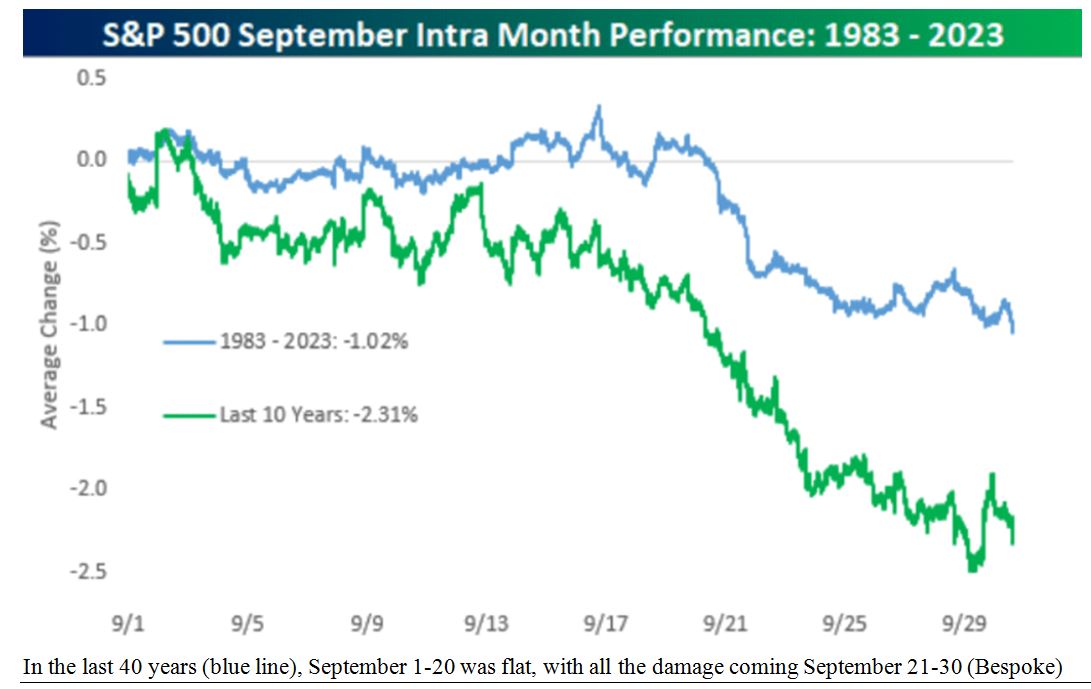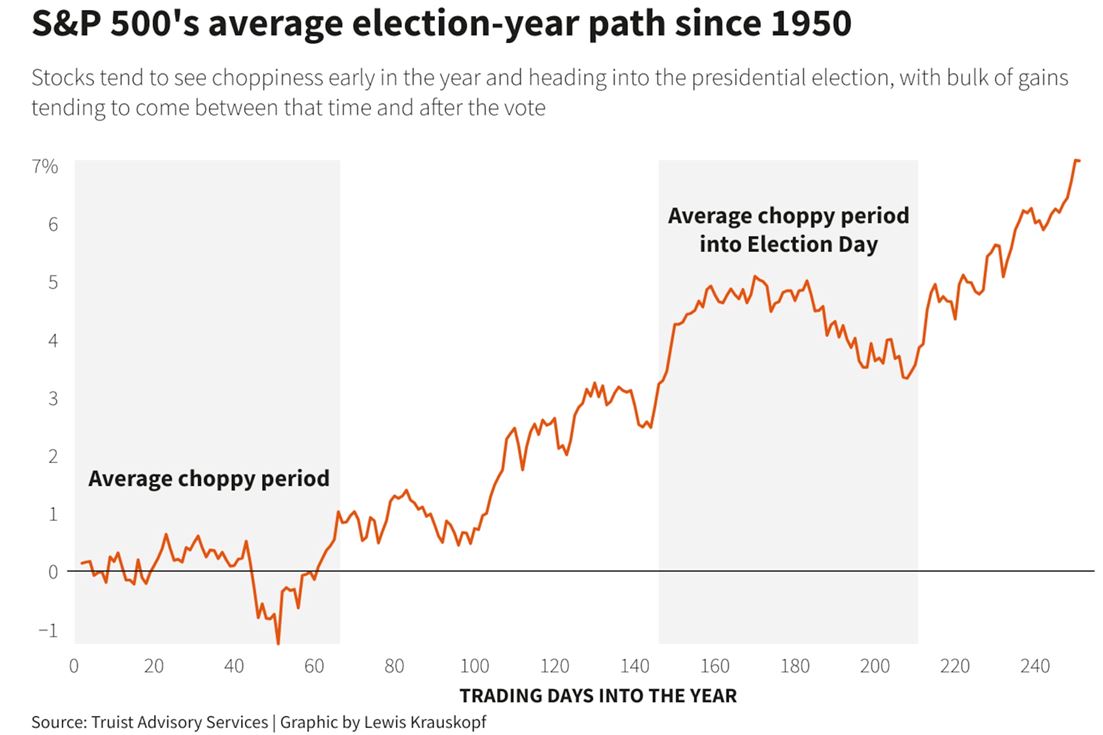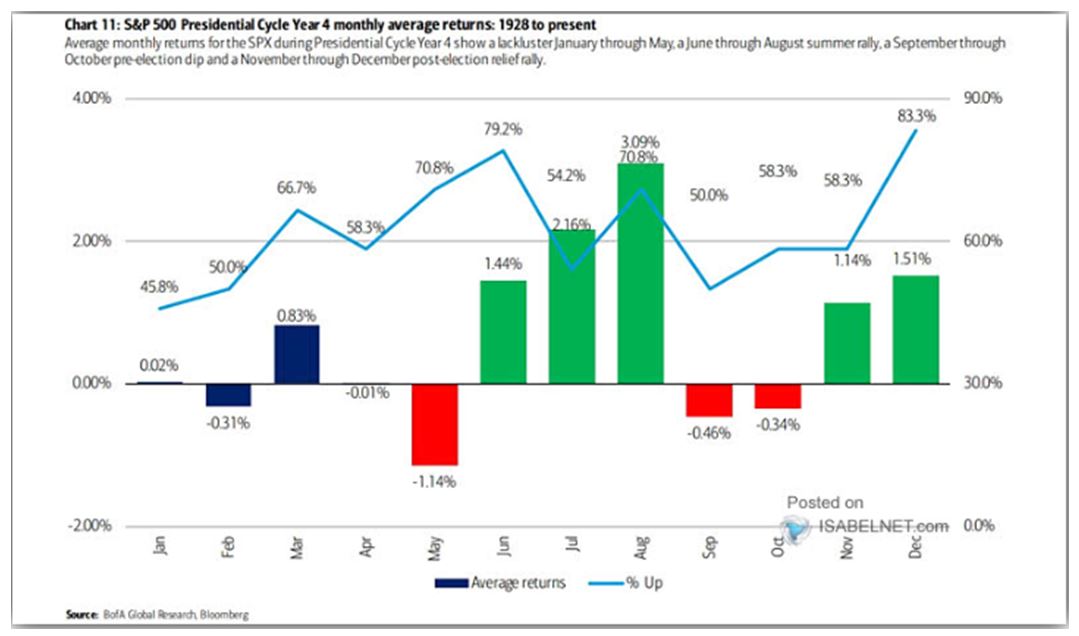by Gary Alexander
September 10, 2024
The first week September 2024 was brutal – with the Dow down nearly 3% in successive daily declines of 627, 220 and 410 points, with only a brief 37-point rise (+0.09%) on Wednesday. That was the good news. The S&P 500 was down -4.25%, with the Russell 2000 and NASDAQ composite each down 5.7%.
That’s “usual” in the sense that September is the worst month of the year, historically, for the U.S. stock market, but it’s not usual in term of monthly timing, since September is usually a tale of two halves, with the first half of September most often being flat, with nearly all of the carnage coming late in the month.

Graphs are for illustrative and discussion purposes only. Please read important disclosures at the end of this commentary.
October is a mirror image of September, with most of the inter-month damage falling in the first half. That’s why I label this danger zone “SEPTOBER,” September 21 to October 21, the first month of fall.
This trend goes back a long time. In the last 123 years, 1900 to 2022, the Dow averaged a mid-year gain of +8.8%, followed by an early autumn decline of 7.8%, coming mostly in September and October, followed by our year-end reward, a near-14% rocket rise from the autumn low to a spring peak.
1974’s “Stagflation September”’
There was a spectacular example of just such a collapse 50 years ago, when the S&P 500 declined 12% in September 1974, capping a quarterly loss of 26%. (The Dow lost 24.6% then, falling from 806 to 607).
September 1974 began on a controversial note when, on September 8, 1974 (a Sunday), new President Gerald Ford pardoned former president Richard Nixon for any crimes he may have committed while in office. On the following Monday morning, the stock market rebelled by staging another free fall. In the following week (September 9-13), the Dow fell over 50 points (-7.5%), while the S&P 500 fell by 8.7%.

September 1974 closed on another negative news event. On September 28 (a Saturday), President Ford concluded an emergency two-day summit on how to fix a combined surge of inflation and recession, happening concurrently, dubbed by some with a fresh word, stagflation. In 1974, inflation hit 10.3% for the full year, the first double-digit inflation year in our peacetime history. Meanwhile, the economy was stagnant: Auto sales were off 20%, housing starts were down 40% and unemployment hit 7.2%.
Coming out of that two-day Stagflation Summit, Ford’s experts had no answer for this unique situation, so on Monday, September 30, the S&P fell 2.2% to bring the monthly loss to 11.93%, and it kept falling, but the good news is that the S&P 500 gained over 72% in the next two years – minus a big inflation tax.
This drama in 1974 wasn’t enhanced by a Presidential election, but it was similar to 2024 in that a sitting president was forced to resign, to be replaced by a Vice President soon to run on his own merits.
The Same Fall Cycle is Amplified During Presidential Election Years
We can track a similar pattern in the Presidential election years (since 1950) – a strong mid-year rise, followed by a significant sag in September and October, then a post-election surge:

Graphs are for illustrative and discussion purposes only. Please read important disclosures at the end of this commentary.
This trend has continued in the last few elections, even though the 2008 election skewered the sample, due to the catastrophic Financial Crisis of 2008-09, which began in earnest with the failure of Lehman Brothers on September 15, 2008. This delivered a market crash totally unrelated to the upcoming Presidential election between Barack Obama and John McCain – with incumbent George W. Bush as a lame duck.

So, with this 2008 data in mind, I’m confident you will allow me to throw out the 2008 market year when examining the last few election cycles. With the 2000 election also controversial due to “hanging chads” in Florida, plus a dot.com market collapse underway, I’ll use the 2004, 2012, 2016 and 2020 elections.
Average Calendar Return of the Last Four “Normal” Presidential Election Years (S&P 500)
(Averaging the 2004, 2012, 2016 and 2020 election years)

If my four-year sample doesn’t impress you, here is a chart that uses the complete data since 1928. The pattern is similar. After a while, you begin to realize that the 4-year Presidential election cycle is one of the more predictable external patterns in stock market history – nothing like hemlines or Super Bowls.

Graphs are for illustrative and discussion purposes only. Please read important disclosures at the end of this commentary.
So, the data all seem to add up – a weak and uncertain patch lies ahead of us, until Election Day, due to uncertainty about which person and political party will dominate. Then we’ll see a year-end rally based mostly on “hope and change,” even though we don’t know much about what the winner can accomplish until the structure of Congress and the new President’s support team takes form and shape in January.
All content above represents the opinion of Gary Alexander of Navellier & Associates, Inc.
Also In This Issue
A Look Ahead by Louis Navellier
Another Downbeat Jobs Report – Plus More Downward Revisions
Income Mail by Bryan Perry
A “Compression Cycle” Hits the Market on Weaker Labor Data
Growth Mail by Gary Alexander
“SEPTOBER” in Market History – Especially in Election Years
Global Mail by Ivan Martchev
This is Just Normal Seasonal Jitters
Sector Spotlight by Jason Bodner
If Given a Choice, Would You Cancel August – or September?
View Full Archive
Read Past Issues Here
About The Author

Gary Alexander
SENIOR EDITOR
Gary Alexander has been Senior Writer at Navellier since 2009. He edits Navellier’s weekly Marketmail and writes a weekly Growth Mail column, in which he uses market history to support the case for growth stocks. For the previous 20-years before joining Navellier, he was Senior Executive Editor at InvestorPlace Media (formerly Phillips Publishing), where he worked with several leading investment analysts, including Louis Navellier (since 1997), helping launch Louis Navellier’s Blue Chip Growth and Global Growth newsletters.
Prior to that, Gary edited Wealth Magazine and Gold Newsletter and wrote various investment research reports for Jefferson Financial in New Orleans in the 1980s. He began his financial newsletter career with KCI Communications in 1980, where he served as consulting editor for Personal Finance newsletter while serving as general manager of KCI’s Alexandria House book division. Before that, he covered the economics beat for news magazines. All content of “Growth Mail” represents the opinion of Gary Alexander
Important Disclosures:
Although information in these reports has been obtained from and is based upon sources that Navellier believes to be reliable, Navellier does not guarantee its accuracy and it may be incomplete or condensed. All opinions and estimates constitute Navellier’s judgment as of the date the report was created and are subject to change without notice. These reports are for informational purposes only and are not a solicitation for the purchase or sale of a security. Any decision to purchase securities mentioned in these reports must take into account existing public information on such securities or any registered prospectus.To the extent permitted by law, neither Navellier & Associates, Inc., nor any of its affiliates, agents, or service providers assumes any liability or responsibility nor owes any duty of care for any consequences of any person acting or refraining to act in reliance on the information contained in this communication or for any decision based on it.
Past performance is no indication of future results. Investment in securities involves significant risk and has the potential for partial or complete loss of funds invested. It should not be assumed that any securities recommendations made by Navellier. in the future will be profitable or equal the performance of securities made in this report. Dividend payments are not guaranteed. The amount of a dividend payment, if any, can vary over time and issuers may reduce dividends paid on securities in the event of a recession or adverse event affecting a specific industry or issuer.
None of the stock information, data, and company information presented herein constitutes a recommendation by Navellier or a solicitation to buy or sell any securities. Any specific securities identified and described do not represent all of the securities purchased, sold, or recommended for advisory clients. The holdings identified do not represent all of the securities purchased, sold, or recommended for advisory clients and the reader should not assume that investments in the securities identified and discussed were or will be profitable.
Information presented is general information that does not take into account your individual circumstances, financial situation, or needs, nor does it present a personalized recommendation to you. Individual stocks presented may not be suitable for every investor. Investment in securities involves significant risk and has the potential for partial or complete loss of funds invested. Investment in fixed income securities has the potential for the investment return and principal value of an investment to fluctuate so that an investor’s holdings, when redeemed, may be worth less than their original cost.
One cannot invest directly in an index. Index is unmanaged and index performance does not reflect deduction of fees, expenses, or taxes. Presentation of Index data does not reflect a belief by Navellier that any stock index constitutes an investment alternative to any Navellier equity strategy or is necessarily comparable to such strategies. Among the most important differences between the Indices and Navellier strategies are that the Navellier equity strategies may (1) incur material management fees, (2) concentrate its investments in relatively few stocks, industries, or sectors, (3) have significantly greater trading activity and related costs, and (4) be significantly more or less volatile than the Indices.
ETF Risk: We may invest in exchange traded funds (“ETFs”) and some of our investment strategies are generally fully invested in ETFs. Like traditional mutual funds, ETFs charge asset-based fees, but they generally do not charge initial sales charges or redemption fees and investors typically pay only customary brokerage fees to buy and sell ETF shares. The fees and costs charged by ETFs held in client accounts will not be deducted from the compensation the client pays Navellier. ETF prices can fluctuate up or down, and a client account could lose money investing in an ETF if the prices of the securities owned by the ETF go down. ETFs are subject to additional risks:
- ETF shares may trade above or below their net asset value;
- An active trading market for an ETF’s shares may not develop or be maintained;
- The value of an ETF may be more volatile than the underlying portfolio of securities the ETF is designed to track;
- The cost of owning shares of the ETF may exceed those a client would incur by directly investing in the underlying securities; and
- Trading of an ETF’s shares may be halted if the listing exchange’s officials deem it appropriate, the shares are delisted from the exchange, or the activation of market-wide “circuit breakers” (which are tied to large decreases in stock prices) halts stock trading generally.
Grader Disclosures: Investment in equity strategies involves substantial risk and has the potential for partial or complete loss of funds invested. The sample portfolio and any accompanying charts are for informational purposes only and are not to be construed as a solicitation to buy or sell any financial instrument and should not be relied upon as the sole factor in an investment making decision. As a matter of normal and important disclosures to you, as a potential investor, please consider the following: The performance presented is not based on any actual securities trading, portfolio, or accounts, and the reported performance of the A, B, C, D, and F portfolios (collectively the “model portfolios”) should be considered mere “paper” or pro forma performance results based on Navellier’s research.
Investors evaluating any of Navellier & Associates, Inc.’s, (or its affiliates’) Investment Products must not use any information presented here, including the performance figures of the model portfolios, in their evaluation of any Navellier Investment Products. Navellier Investment Products include the firm’s mutual funds and managed accounts. The model portfolios, charts, and other information presented do not represent actual funded trades and are not actual funded portfolios. There are material differences between Navellier Investment Products’ portfolios and the model portfolios, research, and performance figures presented here. The model portfolios and the research results (1) may contain stocks or ETFs that are illiquid and difficult to trade; (2) may contain stock or ETF holdings materially different from actual funded Navellier Investment Product portfolios; (3) include the reinvestment of all dividends and other earnings, estimated trading costs, commissions, or management fees; and, (4) may not reflect prices obtained in an actual funded Navellier Investment Product portfolio. For these and other reasons, the reported performances of model portfolios do not reflect the performance results of Navellier’s actually funded and traded Investment Products. In most cases, Navellier’s Investment Products have materially lower performance results than the performances of the model portfolios presented.
This report contains statements that are, or may be considered to be, forward-looking statements. All statements that are not historical facts, including statements about our beliefs or expectations, are “forward-looking statements” within the meaning of The U.S. Private Securities Litigation Reform Act of 1995. These statements may be identified by such forward-looking terminology as “expect,” “estimate,” “plan,” “intend,” “believe,” “anticipate,” “may,” “will,” “should,” “could,” “continue,” “project,” or similar statements or variations of such terms. Our forward-looking statements are based on a series of expectations, assumptions, and projections, are not guarantees of future results or performance, and involve substantial risks and uncertainty as described in Form ADV Part 2A of our filing with the Securities and Exchange Commission (SEC), which is available at www.adviserinfo.sec.gov or by requesting a copy by emailing info@navellier.com. All of our forward-looking statements are as of the date of this report only. We can give no assurance that such expectations or forward-looking statements will prove to be correct. Actual results may differ materially. You are urged to carefully consider all such factors.
FEDERAL TAX ADVICE DISCLAIMER: As required by U.S. Treasury Regulations, you are informed that, to the extent this presentation includes any federal tax advice, the presentation is not written by Navellier to be used, and cannot be used, for the purpose of avoiding federal tax penalties. Navellier does not advise on any income tax requirements or issues. Use of any information presented by Navellier is for general information only and does not represent tax advice either express or implied. You are encouraged to seek professional tax advice for income tax questions and assistance.
IMPORTANT NEWSLETTER DISCLOSURE:The hypothetical performance results for investment newsletters that are authored or edited by Louis Navellier, including Louis Navellier’s Growth Investor, Louis Navellier’s Breakthrough Stocks, Louis Navellier’s Accelerated Profits, and Louis Navellier’s Platinum Club, are not based on any actual securities trading, portfolio, or accounts, and the newsletters’ reported hypothetical performances should be considered mere “paper” or proforma hypothetical performance results and are not actual performance of real world trades. Navellier & Associates, Inc. does not have any relation to or affiliation with the owner of these newsletters. There are material differences between Navellier Investment Products’ portfolios and the InvestorPlace Media, LLC newsletter portfolios authored by Louis Navellier. The InvestorPlace Media, LLC newsletters contain hypothetical performance that do not include transaction costs, advisory fees, or other fees a client might incur if actual investments and trades were being made by an investor. As a result, newsletter performance should not be used to evaluate Navellier Investment services which are separate and different from the newsletters. The owner of the newsletters is InvestorPlace Media, LLC and any questions concerning the newsletters, including any newsletter advertising or hypothetical Newsletter performance claims, (which are calculated solely by Investor Place Media and not Navellier) should be referred to InvestorPlace Media, LLC at (800) 718-8289.
Please note that Navellier & Associates and the Navellier Private Client Group are managed completely independent of the newsletters owned and published by InvestorPlace Media, LLC and written and edited by Louis Navellier, and investment performance of the newsletters should in no way be considered indicative of potential future investment performance for any Navellier & Associates separately managed account portfolio. Potential investors should consult with their financial advisor before investing in any Navellier Investment Product.
Navellier claims compliance with Global Investment Performance Standards (GIPS). To receive a complete list and descriptions of Navellier’s composites and/or a presentation that adheres to the GIPS standards, please contact Navellier or click here. It should not be assumed that any securities recommendations made by Navellier & Associates, Inc. in the future will be profitable or equal the performance of securities made in this report.
FactSet Disclosure: Navellier does not independently calculate the statistical information included in the attached report. The calculation and the information are provided by FactSet, a company not related to Navellier. Although information contained in the report has been obtained from FactSet and is based on sources Navellier believes to be reliable, Navellier does not guarantee its accuracy, and it may be incomplete or condensed. The report and the related FactSet sourced information are provided on an “as is” basis. The user assumes the entire risk of any use made of this information. Investors should consider the report as only a single factor in making their investment decision. The report is for informational purposes only and is not intended as an offer or solicitation for the purchase or sale of a security. FactSet sourced information is the exclusive property of FactSet. Without prior written permission of FactSet, this information may not be reproduced, disseminated or used to create any financial products. All indices are unmanaged and performance of the indices include reinvestment of dividends and interest income, unless otherwise noted, are not illustrative of any particular investment and an investment cannot be made in any index. Past performance is no guarantee of future results.
